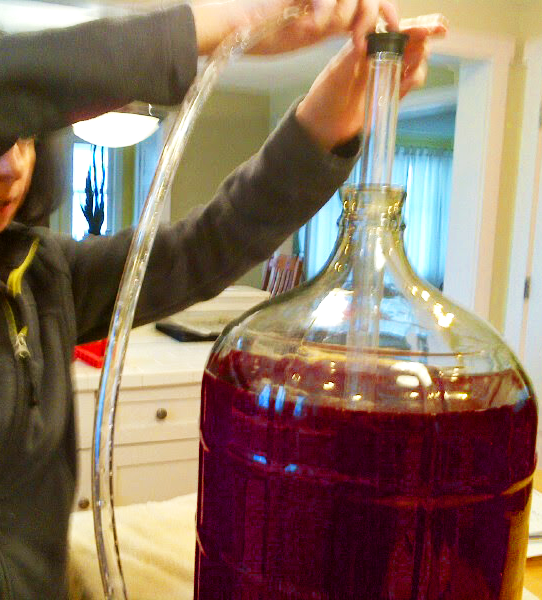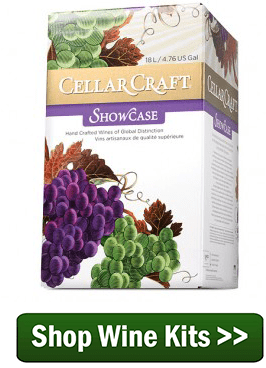Last time, I updated you all on the progress of the Rosso Fortissimo wine ingredient kit, I had just put it to bed for secondary fermentation. Things have been going well so far, and — fingers crossed — they continue to do so.
updated you all on the progress of the Rosso Fortissimo wine ingredient kit, I had just put it to bed for secondary fermentation. Things have been going well so far, and — fingers crossed — they continue to do so.
According to the instructions that came with this kit, I was supposed to leave the wine in secondary fermentation until at least day 20. Well, I ended up leaving it until day 22, basically because that’s how it worked out for my schedule. I figured leaving it an extra day or two wouldn’t hurt it at all — at the very least, I’d be ensuring that secondary fermentation was complete!
Checking the specific gravity with my hydrometer on day 22, it read 0.998. The instructions say secondary fermentation is complete and you’re ready to move on and siphon the wine into a clean carboy if the specific gravity is 0.998 or less, so I took that as the green light to go!
Next, I added the packet of potassium metabisulfite that came with the wine kit and stirred vigorously for two minutes per the instructions. I then realized that I actually wanted to rack the wine into a different vessel BEFORE this step, but it was too late at this point to do much about that. Technically, the suggestion to rack the wine wasn’t in the instructions until after the potassium metabisulfite addition, but I would have felt better anyway if I had done it first, just in case I accidentally left some behind in the original vessel. Maybe this doesn’t even matter — we’ll see.
Anyway, I then siphoned the wine immediately after the 2 minute stirring step for the potassium metabisulfite.
At this point, the instructions said that if gas was still being released to go ahead and stir the wine over the next day or two. Well, it was hard to say if it was, because I’ll be honest I didn’t pay too close attention to it, but I decided better safe than sorry and I would go ahead and stir the wine a few times over the next two days.
Two days later….
 I then added the potassium sorbate, and subsequently siphoned the wine again into a clean carboy so I could actually see if the wine was clearing or not. I know I know, I really should have racked the wine first prior to adding the potassium sorbate just in case I accidentally left some behind in the process, but like the last time, I just didn’t think about it. Here’s hoping I did it swiftly enough that none of it had a chance to settle.
I then added the potassium sorbate, and subsequently siphoned the wine again into a clean carboy so I could actually see if the wine was clearing or not. I know I know, I really should have racked the wine first prior to adding the potassium sorbate just in case I accidentally left some behind in the process, but like the last time, I just didn’t think about it. Here’s hoping I did it swiftly enough that none of it had a chance to settle.
After siphoning the wine into a carboy that I could actually see through, I added the packet of kieselsol and stirred gently for two minutes.
Then, I waited one hour.
Next, I added the packet of chitosan and stirred gently for one minute.
Then, I waited three hours.
Finally, I stirred the wine again for two minutes, re-fit the airlock, and said goodbye until day 42.
I realized I made a couple minor errors this time, but I’m hoping that this wine ingredient kit will be a little forgiving and it won’t really matter in the end. Here’s hoping for clear, tasty wine in the next couple weeks!
———————————–
 My name is Leigh Erwin, and I am a brand-spankin’ new home winemaker! E. C. Kraus has asked me to share with you my journey from a first-time dabbler to an accomplished home winemaker. From time to time I’ll be checking in with this blog and reporting my experience with you: the good, bad — and the ugly.
My name is Leigh Erwin, and I am a brand-spankin’ new home winemaker! E. C. Kraus has asked me to share with you my journey from a first-time dabbler to an accomplished home winemaker. From time to time I’ll be checking in with this blog and reporting my experience with you: the good, bad — and the ugly.

Congrats on starting the process!
My original attempt at wine making was also a kit. It turned out fine even though my “flow” was also imperfect. Since the first kit, I have done everything from scratch including going and picking the fruit. Locally fruits (raspberry, blueberry, strawberry, rhubarb, etc) are plentiful seasonally and lots of U-pick” farms so I get to control everything but growing and the weather. I had to drive to eastern Washington for grapes but it made for a fun weekend.
I have only made 6 wines amounting to 40 gallons or approximately 16 case of wine. Chardonnay (the original kit); a Cabernet blend with grapes from the Yakima Valley. Raspberry, blueberry and strawberry from the Puyallup valley and Rhubarb from the Olympic Peninsula. Pinot Noir and Ruby Red Grapefruit are next… Here is what I have discovered on my journey.
1) Product quality matters. This includes using glass, not plastic for long term aging.
2) Standardize your sources. When you are a return customer they get to know you and are very sharing of their experiences. This is true for the produce and the equipment. This reduces your risk for loss due to mistakes.
3) Sanitation is critical. Don’t be casual about this.
3) In wine making, patience really is a virtue. With well managed environments (equipment, ingredients, process, temp, light and humidity), your biggest enemy is ones need for quick results. I rack the wine several times over the course of a year. I task it each step of the way to ensure quality, to judge its progress and to decide what I want to do before bottling in terms of things like conditioning, sweetening, blending, etc.
4) Finding an outlet for my vice/hobby requires thought! My biggest problem is I don’t drink much wine. I sample it along the way. I want to keep a couple of bottles to see what it does over time. But I have to find willing consumers. So I have a dinner or a neighborhood function. We do a wine tasting. Everyone has a great time and I move a bunch of product with great feedback of what they would like to see in the next batch.
#4 really adds to the fun for me. The sharing piece takes my curiosity about the product/process/outcome and turns it into great conversation, good friends and much joy.
Thanks for sharing and thanks to EC Kraus for all the help along the way.
Ken, thanks for the great advice.
Please remember that the whole idea behind racking is to leave sediment behind. Next time, transfer or rack it first before adding anything. This time, I would plan to each again in a week.
It should say that you need to rack now after a week to get rid of the sediment you should have left behind last racking.